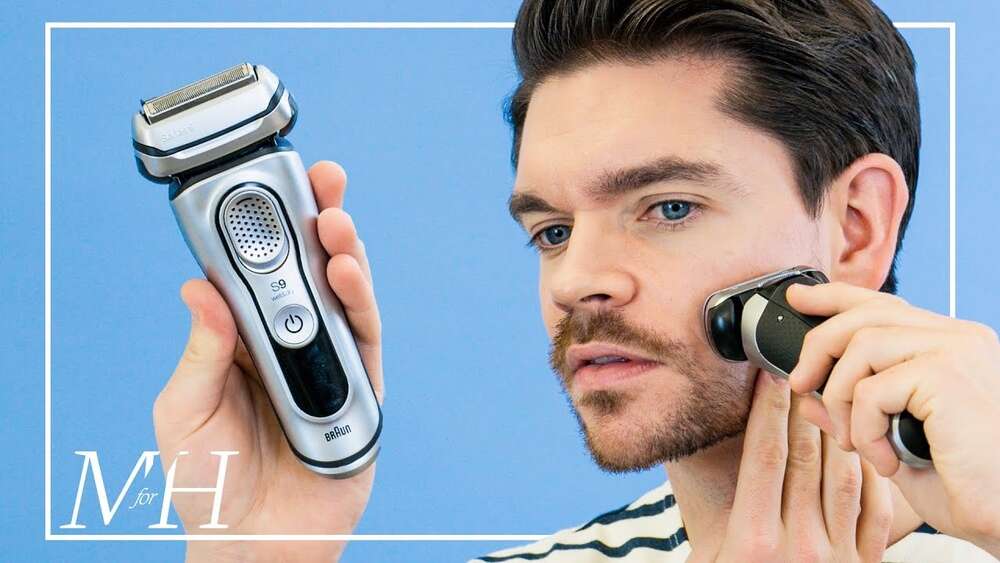Shaving with an electric razor can be a game-changer for your daily grooming routine, but only if you know the right techniques. Are you tired of irritation, uneven cuts, or just not getting that clean, smooth finish you want?
This guide will show you exactly how to shave with an electric razor to get the best results—whether you prefer a quick dry shave or a closer wet shave. By following simple steps tailored to your skin and hair type, you’ll save time, avoid common mistakes, and enjoy a comfortable, polished look every day.
Keep reading to discover the secrets that barbers and grooming experts swear by!
Choosing The Right Electric Razor
Choosing the right electric razor is the first step to a comfortable shave. The right razor fits your needs and skin type. It makes shaving easier and reduces skin irritation. Understanding the types and features helps you pick the best one for you.
Types Of Electric Razors
There are two main types of electric razors: foil and rotary. Foil razors have thin metal screens that cover oscillating blades. They work well for sensitive skin and provide a close shave. Rotary razors have circular blades that move under spinning heads. They handle longer hair and curved areas better. Choose a type based on your hair growth and skin comfort.
Features To Consider
Look for features that improve your shaving experience. A waterproof design allows for wet or dry use. A cordless razor with a long battery life offers more freedom. Adjustable speed settings help control the shave pressure. Some models include a pop-up trimmer for sideburns and mustaches. Ease of cleaning is important for hygiene and razor longevity.
Matching Razor To Skin Type
Skin type affects razor choice. Sensitive skin needs a gentle razor with smooth blades. Foil razors are best for this type. Normal skin can use either type depending on hair style. Thick or coarse hair benefits from rotary razors for better cutting. Dry skin may prefer wet shaving options with a waterproof razor. Always test the razor on a small skin area first.
Preparing Your Skin And Beard
Preparing your skin and beard is key for a smooth shave with an electric razor. Clean skin and well-prepared hair reduce irritation and improve razor performance. Follow simple steps to get your face ready before you start shaving.
Cleansing And Exfoliating
Start by washing your face with warm water and a gentle cleanser. This removes dirt, oil, and dead skin cells. Exfoliating once or twice a week helps clear away dry skin. Clean, exfoliated skin allows the razor to glide smoothly and prevents clogged blades.
Softening Hair For Easier Shaving
Soft hair is easier to cut and less likely to pull. Use warm water or a warm towel on your face for a few minutes. This opens pores and softens the beard. Soft hair reduces tugging and leaves a closer shave with less effort.
When To Shave Wet Vs Dry
Dry shaving is quick and gentle, perfect for sensitive skin or busy days. Wet shaving with shaving cream or gel gives a closer, smoother shave. It also helps reduce friction and irritation. Choose wet shaving for a thorough shave. Pick dry shaving for speed and comfort.
Techniques For Dry Shaving
Dry shaving with an electric razor offers a fast and easy grooming solution. It is perfect for quick shaves and sensitive skin. Using the right techniques makes your shave smoother and reduces skin irritation. Follow these steps to get the best results from dry shaving.
Proper Razor Handling
Hold the razor firmly but comfortably. Keep the shaver’s head flat against your skin. Move the razor in small, circular motions for an even cut. Avoid pressing too hard, which can cause skin irritation. Let the razor do the work, not your hand.
Shaving Speed And Pressure
Shave at a slow and steady pace. Quick movements can miss hairs or cause cuts. Use light pressure to protect your skin. Applying heavy pressure does not improve the shave quality. Be patient for a smoother and safer shave.
Tips To Reduce Irritation
Clean your skin before shaving to remove dirt and oils. Dry your face thoroughly for better razor contact. Avoid shaving over the same area multiple times. Moisturize your skin after shaving to soothe and hydrate. Use a gentle aftershave balm to calm any redness or irritation.

Credit: www.wikihow.com
Techniques For Wet Shaving
Wet shaving with an electric razor enhances comfort and closeness. It softens hair and protects skin from irritation. Using water and shaving products prepares your face for a smoother shave. This method suits those who want a cleaner finish with less tugging.
Using Shaving Cream Or Gel
Apply a thin layer of shaving cream or gel on your damp face. These products create a protective barrier between skin and razor. They help reduce friction and prevent razor burn. Choose a cream or gel designed for sensitive skin. This keeps your skin calm and hydrated during the shave.
Benefits Of Warm Water
Warm water opens pores and softens facial hair. It makes hair easier to cut, leading to less pulling. Splash your face with warm water before shaving. You can also shave after a warm shower for best results. This step prepares your skin and improves razor glide.
Achieving A Closer Finish
Use short, gentle strokes with the electric razor. Shave against the direction of hair growth for closeness. Avoid pressing too hard; let the razor do the work. Rinse the razor often to keep blades clean. Finish by rinsing your face with cold water to close pores.
Post-shave Care
Proper post-shave care helps keep your skin healthy and comfortable after using an electric razor. It reduces irritation and extends the life of your razor. Follow simple steps to clean your razor, soothe your skin, and protect it with moisturizers. This routine makes every shave better and your skin smoother.
Cleaning Your Razor
Cleaning your electric razor after each use is very important. Remove any hair clippings from the blades and head. Use the brush that came with your razor or a small soft brush. Rinse the razor under water if it is waterproof. Dry it completely before storing. This prevents rust and keeps the razor sharp.
Soothing Your Skin
Shaving can cause small cuts or redness. Calm your skin by applying a cool, damp cloth. This helps reduce inflammation and tightness. Avoid using alcohol-based aftershaves as they can dry out your skin. Choose gentle, fragrance-free products designed for sensitive skin. Let your skin breathe before applying any creams.
Moisturizing And Protection
Moisturizing is key to smooth, healthy skin after shaving. Use a light, non-greasy moisturizer to keep skin hydrated. Look for ingredients like aloe vera or vitamin E. These soothe and repair the skin barrier. Apply sunscreen if you go outdoors to protect freshly shaved skin from sun damage. Hydrated skin feels softer and looks better.
Common Mistakes To Avoid
A smooth shave with an electric razor needs care and attention. Avoiding common mistakes helps protect your skin and improve the shave quality. These errors can cause irritation, cuts, or uneven results. Learn what to watch out for below.
Using Excessive Pressure
Pressing the razor too hard can hurt your skin. Electric razors work best with light, gentle strokes. Too much pressure may cause redness and irritation. Let the razor glide softly over your face instead of pushing it down.
Shaving Too Quickly
Rushing through your shave leads to missed spots and skin irritation. Take your time to move the razor slowly and steadily. Slow shaving helps the blades catch all hairs for a cleaner result. Patience improves comfort and skin health.
Neglecting Razor Maintenance
Dirty or dull blades reduce shaving performance and cause skin problems. Clean your electric razor after every use to remove hair and oil buildup. Replace blades or foil as recommended by the manufacturer. Proper care keeps your razor sharp and your skin safe.
Troubleshooting Skin Issues
Troubleshooting skin issues is important for a comfortable shave with an electric razor. Skin problems like razor burn, ingrown hairs, and sensitivity can make shaving painful. Understanding how to handle these issues helps keep your skin healthy and smooth.
Dealing With Razor Burn
Razor burn causes redness and irritation after shaving. Use a gentle touch and avoid pressing the razor too hard. Shave in slow, circular motions to reduce friction. Applying a soothing aftershave balm calms irritated skin. Avoid shaving over the same area repeatedly to prevent burn.
Preventing Ingrown Hairs
Ingrown hairs occur when hair curls back into the skin. Exfoliate your skin regularly to remove dead cells. This clears pores and helps hair grow outward. Use an electric razor with a foil or rotary head designed to cut hair cleanly. Avoid shaving too closely to reduce the risk of ingrown hairs.
Managing Sensitive Skin
Sensitive skin needs extra care during shaving. Choose an electric razor made for sensitive skin types. Shave after washing your face with warm water to soften hair. Use a pre-shave lotion to protect the skin. Limit shaving frequency to give skin time to heal. Always clean your razor to avoid bacteria buildup.

Credit: www.menshealth.com
Advanced Tips For A Smooth Finish
Achieving a smooth finish with an electric razor takes more than just basic technique. Using advanced tips helps reduce irritation and leaves skin feeling soft. These methods work well for all skin types and improve every shave’s quality.
Shaving Against The Grain Safely
Shaving against the grain can give a closer shave with an electric razor. Move the razor slowly and gently to avoid skin damage. Stop if you feel irritation or discomfort. Use short strokes and keep the skin tight for better results. This approach reduces missed hairs and improves smoothness.
Using Pre-shave Oils
Applying pre-shave oil softens hair and protects skin. It creates a light barrier that reduces friction from the razor. Massage a few drops into your face before shaving. This step helps prevent razor burn and makes the shave glide smoothly. Pre-shave oils are especially good for dry or sensitive skin.
Incorporating A Multi-pass Routine
Shaving in multiple passes improves closeness and skin health. Start by shaving with the grain on the first pass. Then, shave across the grain for a closer cut. Finish by shaving gently against the grain if your skin allows. Clean the razor between passes to keep it sharp and effective. This routine reduces irritation and gives a polished finish.

Credit: www.wikihow.com
Frequently Asked Questions
Is It Better To Shave Wet Or Dry With Electric Razor?
Shaving wet with an electric razor offers a closer, smoother shave by softening hair and reducing friction. Dry shaving is faster, gentler, and better for sensitive skin. Choose wet shaving for smoothness; pick dry shaving for speed or sensitive skin care.
What Is The Correct Way To Shave With An Electric Razor?
Shave with an electric razor by cleaning your face and shaving dry or wet. Use circular motions for rotary razors and straight strokes for foil razors. Avoid pressing hard to prevent irritation. Rinse the razor often and moisturize after shaving for smooth skin.
Should I Shave Up Or Down With An Electric Razor?
Shave against hair growth (upward) for a closer cut with an electric razor. Use gentle, short strokes to avoid irritation.
What Do You Put On Your Skin Before Electric Shaving?
Apply a pre-shave lotion or gel to soften hair and protect skin before electric shaving. For sensitive skin, use moisturizing products.
Conclusion
Shaving with an electric razor can be simple and effective. Choose wet or dry shaving based on your skin and time. Always prepare your skin well for a smooth shave. Move the razor gently and clean it after use. With practice, you will find a routine that suits you.
Enjoy a comfortable shave every day without irritation. An electric razor offers convenience and care in one tool. Keep your skin healthy and your shave neat.

Rubel Miah is the co-founder and senior writer at MyFashionGrid, where he shares practical and expert-backed male grooming advice. With years of experience testing grooming products and perfecting men’s style routines, Rubel’s goal is to help men look sharp and feel confident—whether it’s mastering the perfect shave, finding the right haircut, or upgrading their daily grooming game. When he’s not writing, you’ll find him experimenting with new razors or exploring the latest trends in men’s fashion and self-care.

